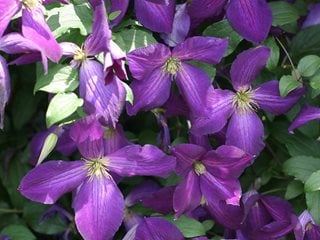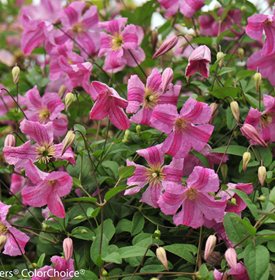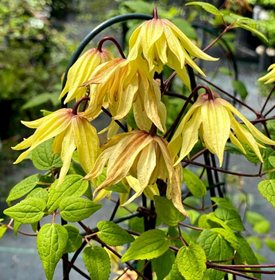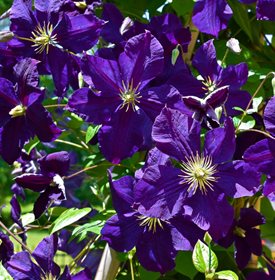HOW TO GROW & CARE FOR CLEMATIS PLANTS
Bring long-lasting color to your garden with this flowering vineClematis, often called the Queen of Climbers, are easy-care perennial vines with flowers in many colors, shapes, and sizes. They can cover posts, pergolas, fences, or spill gracefully from containers, sometimes growing up to 8 feet in a season. New plants may take a few years to reach their full show.
On this page: Basics | Types | Planting | Care | Pictures | Design Ideas | Cutting & Arranging | FAQs
On this page:
- BASICS
- TYPES OF CLEMATIS
- PLANTING CLEMATIS
- CLEMATIS CARE AND MAINTENANCE
- CLEMATIS VARIETIES
- LANDSCAPE DESIGN TIPS
- CUTTING & ARRANGING CLEMATIS
- FREQUENTLY ASKED QUESTIONS
CLEMATIS BASICS
Zones:
Most varieties are suitable for zones 4-9; with a few varieties hardy to zone 3 and others heat tolerant to zone 10.
Height/Spread:
Varieties from low-growing, trailing shrubs to climbers that can reach 30 to 50 feet.
Exposure:
Clematis need 5 to 6 hours of sun daily, but do appreciate some light shade in hotter climates. Excessive sun can cause petals to fade on larger-flowered varieties.
Bloom time:
There are early-blooming varieties (March to June), mid-season bloomers (April to June) and late bloomers (July to first frost).
Color:
Varieties available in shades of blue, pink, deep purple, red, and white.
Flower shape and size:
Single, double, semi-double, star-shaped, and bell-like forms, from 3 to 8 inches across.
Toxicity:
The ASPCA lists clematis as being toxic to dogs, cats, and horses. It is noted, however, that it has a very bitter taste and may keep animals from ingesting large amounts.
Deer resistance:
Although listed as deer resistant; no plant is completely deer proof, as deer have been known to eat just about anything if hungry enough.
"Beyond their stunning flowers, some clematis varieties offer attractive seed heads in the late season, adding further ornamental value. Their versatility, coupled with their diverse beauty, makes the clematis vine a cherished addition to gardens worldwide."
— Author, speaker, and home gardener Stacy Ling, Bricks & Blooms
TYPES OF CLEMATIS
Varieties can be broken down into 3 groups based on when their flower buds are formed.
C. macropetala
C. montana
C. armandii
‘Dr. Ruppel’
‘Ernest Markham’
ARE THERE ANY CLEMATIS THAT AREN'T VINES?
'Stand by Me' is an herbaceous, non-vining bush clematis that dies back to the ground at the end of the season. 'Stand by Me' blooms blue, pink, or lavender bell-shaped flowers from late spring until mid-summer and grows to 3 feet tall and wide. Grow in full sun to light shade. Benefits from staking or support from surrounding plants.
Zones 3-7
"Broad, green foliage completes the package of this unique perennial. New leaves have a bronze cast to the undersides." — Proven Winners Perennials.
HOW TO PLANT CLEMATIS

Unlike planting practices for most plants, clematis should be planted deeper than in their original pot. Photo by: Avalon / Alamy Stock Photo.
When to plant:
Plant in early spring just as they are going into their growth phase or later in the fall. Although nurseries may promote and sell them mid-to-late spring when in bloom, this isn't necessarily the best time to plant as there's not enough time to establish their roots before summer heat arrives.
Where to plant:
Consider the mature size of the plant and its growth habit to allow enough space, especially for the faster growers. Plant where the leaves will get sun, but the roots and base of the plant are shaded; the north side of a smaller shrub is ideal.
How to plant:
Plant clematis deeper than most plants, with the crown approximately 3 to 5 inches below the soil line. This will help encourage stems to emerge from dormant buds, making for a stronger multi-stemmed base. Water thoroughly after planting.
Planting Tips:
- A superphosphate fertilizer can be added to the bottom of the planting hole and covered with an inch of soil.
- A 3-inch layer of mulch will help keep the roots cool, but should be kept away from the base of the plant by about 5 to 6 inches.
- Handle roots with care; damage often kills young plants.
- Wear gloves when handling, as clematis may cause skin irritation.
CLEMATIS CARE
Pruning:
The key to pruning clematis correctly is knowing what type you have. If you're unsure, the best plan is to wait and see when it starts blooming, as this will dictate how and when it should be pruned. If in doubt, there are a few simple rules you can fall back on: Don’t prune before flowering, don’t remove any stems with developing buds, and never prune in the fall as this may trigger new growth that will be susceptible to winter damage.
- Group 1: Blooms on old wood. Prune lightly right after flowering to remove any dead or damaged stems. Other stems can be cut back to maintain shape and size.
- Group 2: Blooms on both old and new wood. Prune lightly in early spring before they begin to grow. Remove any dead, damaged or spindly stems to just above a pair of healthy buds. The remaining stems can also be cut back to where good buds are visible.
- Group 3: Blooms on new wood. Prune hard in late winter down to 1 to 2 feet from the soil line. Don’t worry, they’re vigorous growers and can grow up to 8 feet in a single season.
For all 3 groups, a harder pruning in the first 2 years can help encourage a more shrub-like, multi-stemmed plant.
When deadheading, 12 to 18 inches of stem can be cut back. This will help rejuvenate your vine and keep it looking nice and healthy.
Soil:
Clematis prefer slightly alkaline, rich soil but tolerate a range if it’s well-drained and mulched to keep roots cool.
Fertilizer:
Clematis are heavy feeders. Apply a balanced fertilizer once a month during the growing season, the stop just before flowering. Feeding during bloom can push leafy growth at the expense of flowers. Resume light feeding after blooming to support rebloomers and for next year's growth.
Watering:
Under normal conditions, they need about an inch of water weekly once established. In warmer climates or during extreme heat, water deeply and more frequently; this will also help to keep the roots cool.
Support:
Clematis attach themselves to host plants or structures with their leaf stalks but need help to climb vertically. Secure stems to a support or trellis to encourage upward growth.
Diseases and Pests:
Scale, whiteflies, earwigs and aphids can be a problem. Common diseases are clematis wilt, powdery mildew, rust, fungal spots and stem cankers.
"The symptoms of clematis wilt are very defining and include sudden stem collapse, often just as the flower buds are about to open. Within just a few days, the stem and its leaves turn black." — Missouri Botanical Garden (learn more).
CLEMATIS VARIETIES
LANDSCAPE DESIGN IDEAS
- Combine early, mid-, and late-bloomers for color from spring to frost.
- Use vigorous climbers to quickly cover arbors, pergolas, or fences.
- Grow compact types like ‘Cezanne’ or ‘Crystal Fountain’ in containers or small spaces.
- Let herbaceous types such as C. heracleifolia sprawl as groundcover.
- Add vertical interest in small gardens by training clematis up trellises or posts.
- Pair with peonies, lilies, or roses for layered seasonal blooms.
CUTTING & ARRANGING CLEMATIS
Clematis can last up to two weeks as cut flowers. Harvest in the morning when buds are just starting to open, cut stems well below a healthy set of leaves, and display them in cool conditions out of direct sun. Use their flexible vines for draping in arrangements, or float individual blooms in a shallow bowl.
FREQUENTLY ASKED QUESTIONS
How long does it take for clematis to become established?
Most clematis need 2–3 years before they really hit their stride, so don’t worry if the first season is modest.
Why isn't my clematis blooming?
Bloom failure is often due to planting too deep or shallow, improper pruning for its group, or too much shade.
Can clematis grow in pots?
Yes, many compact varieties (like C. ‘Cezanne’) are ideal for containers. Choose a large, deep pot with rich soil and provide a trellis or support.
How do I know what group my clematis belongs to?
If you don’t know the variety, observe when it blooms: early (Group 1), spring to early summer (Group 2), or summer to fall (Group 3).
ABOUT THE AUTHOR
Linda Hagen is a writer and content coordinator at GardenDesign.com, where she combines firsthand gardening experience with expert insights. Based in Southern California (Zone 9B), she’s passionate about vibrant, pollinator-friendly gardens and believes the best lessons come from a trial-and-error approach to growing .
RELATED:
Flowering Vines for Your Garden
Cottage Garden Ideas












